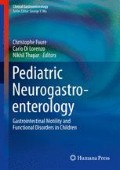Abstract
In 1996, a team of pediatric gastroenterologists put together for the first time all the disorders of the digestive system that they thought would be of functional origin in infants and children. Using their experience, they established the criteria by consensus after reviewing the literature. The Rome criteria for pediatric functional gastrointestinal disorders were born and published in 1999. This initiative was inspired and supported by the adult team that published the first Rome criteria for adults in 1990. The pediatric criteria were later revised by two teams of pediatric gastroenterologists, including a psychologist, and published in 2006. The criteria were grouped according to age and divided in two categories, one pertaining to infants and toddlers and the other one to children and adolescents. They were also classified according to digestive complaint instead of anatomical region.
Using the criteria, an increasing number of clinical and research studies on functional gastrointestinal disorders in children have been published, allowing comparisons of results from different parts of the world. The criteria also brought tremendous support to both the clinician and the patient by providing a positive diagnosis and allowing comparisons between different approaches and treatments in children selected accordingly.
Access this chapter
Tax calculation will be finalised at checkout
Purchases are for personal use only
References
Milholland AV, Wheeler SG, Heieck JJ. Medical assessment by a Delphi group opinion technic. N Engl J Med. 1973;288:1272–5.
Thompson WG. The road to rome. Gastroenterology. 2006;130:1552-6.
Drossman DA, Richter JE, Talley NJ, et al. The functional gastrointestinal disorders: diagnosis, pathophysiology and treatment: a multinational consensus. Boston; 1994. 370 p.
Wong RK, Tan JS, Drossman DA. Here’s my phone number, don’t call me: physician accessibility in the cell phone and e-mail era. Dig Dis Sci. 2010;55:662–7.
Rasquin-Weber A, Hyman PE, Cucchiara S, et al. Childhood functional gastrointestinal disorders. Gut. 1999;45 Suppl 2:II60–8.
Hyman PE, Rasquin-Weber A, Fleisher D, et al. Childhood functional gastrointestinal disorders. In: Drossman D, editor. The functional gastrointestinal disorders. McLean, VA: Degnon Associates; 2000. p. 533–75.
Milla PJ. Irritable bowel syndrome in childhood. Gastroenterology. 2001;120:287–90.
Van Ginkel R, Voskuijl WP, Benninga MA, et al. Alterations in rectal sensitivity and motility in childhood irritable bowel syndrome. Gastroenterology. 2001;120:31–8.
Di Lorenzo C, Youssef NN, Sigurdsson L, et al. Visceral hyperalgesia in children with functional abdominal pain. J Pediatr. 2001;139:838–43.
Caplan A, Walker L, Rasquin A. Development and preliminary validation of the questionnaire on pediatric gastrointestinal symptoms to assess functional gastrointestinal disorders in children and adolescents. J Pediatr Gastroenterol Nutr. 2005;41:296–304.
Caplan A, Walker L, Rasquin A. Validation of the pediatric Rome II criteria for functional gastrointestinal disorders using the questionnaire on pediatric gastrointestinal symptoms. J Pediatr Gastroenterol Nutr. 2005;41:305–16.
Di Lorenzo C, Rasquin A, Forbes D, et al. Childhood functional gastrointestinal disorders: child/adolescent. In: Drossman A, editor. The functional gastrointestinal disorders. Durham, NC: BW&A Books Inc.; 2006. p. 723–7.
Rasquin A, Di Lorenzo C, Forbes D, et al. Childhood functional gastrointestinal disorders: child/adolescent. Gastroenterology. 2006;130:1527–37.
Hyman PE. Will the Rome criteria help pediatrics? J Pediatr Gastroenterol Nutr. 2008;47:700–3.
Baber KF, Anderson J, Puzanovova M, et al. Rome II versus Rome III classification of functional gastrointestinal disorders in pediatric chronic abdominal pain. J Pediatr Gastroenterol Nutr. 2008;47:299–302.
Chogle A, Dhroove G, Sztainberg M, et al. How reliable are the Rome III criteria for the assessment of functional gastrointestinal disorders in children? Am J Gastroenterol. 2010;105:2697–701.
Saps M, Youssef N, Miranda A, et al. Multicenter, randomized, placebo-controlled trial of amitriptyline in children with functional gastrointestinal disorders. Gastroenterology. 2009;137:1261–9.
Saps M, Pensabene L, Turco R, et al. Rotavirus gastroenteritis: precursor of functional gastrointestinal disorders? J Pediatr Gastroenterol Nutr. 2009;49:580–3.
Saps M, Pensabene L, Di Martino L, et al. Post-infectious functional gastrointestinal disorders in children. J Pediatr. 2008;152:812–6.
Halac U, Noble A, Faure C. Rectal sensory threshold for pain is a diagnostic marker of irritable bowel syndrome and functional abdominal pain in children. J Pediatr. 2010;156:60–5.
Shulman RJ, Eakin MN, Czyzewski DI, et al. Increased gastrointestinal permeability and gut inflammation in children with functional abdominal pain and irritable bowel syndrome. J Pediatr. 2008;153:646–50.
Youssef NN, Di Lorenzo C. Pediatric gastrointestinal motility—future directions and challenges. Dig Dis. 2006;24:308–12.
Lane RD, Waldstein SR, Chesney MA, et al. The rebirth of neuroscience in psychosomatic medicine. Part I: Historical context, methods, and relevant basic science. Psychosom Med. 2009;71:117–34.
Lane RD, Waldstein SR, Critchley HD, et al. The rebirth of neuroscience in psychosomatic medicine. Part II: Clinical applications and implications for research. Psychosom Med. 2009;71:135–51.
Grover M, Herfarth H, Drossman DA. The functional-organic dichotomy: postinfectious irritable bowel syndrome and inflammatory bowel disease-irritable bowel syndrome. Clin Gastroenterol Hepatol. 2009;7:48–53.
Hyman PE, Monagas J. Rectal perceptual hypersensitivity: a biomarker for pediatric irritable bowel syndrome. J Pediatr. 2010;156:5–7.
Author information
Authors and Affiliations
Corresponding author
Editor information
Editors and Affiliations
Rights and permissions
Copyright information
© 2013 Springer Science+Business Media New York
About this chapter
Cite this chapter
Rasquin, A. (2013). History and Definition of the Rome Criteria. In: Faure, C., Di Lorenzo, C., Thapar, N. (eds) Pediatric Neurogastroenterology. Clinical Gastroenterology. Humana Press, Totowa, NJ. https://doi.org/10.1007/978-1-60761-709-9_29
Download citation
DOI: https://doi.org/10.1007/978-1-60761-709-9_29
Published:
Publisher Name: Humana Press, Totowa, NJ
Print ISBN: 978-1-60761-708-2
Online ISBN: 978-1-60761-709-9
eBook Packages: MedicineMedicine (R0)

